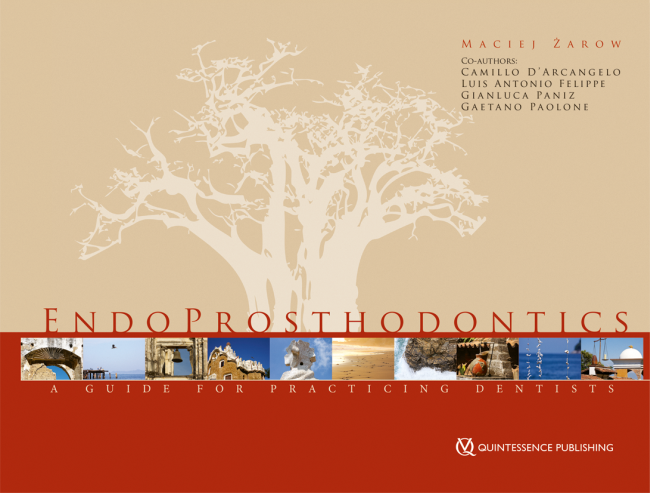International Journal of Periodontics & Restorative Dentistry, 4/2020
DOI: 10.11607/prd.4500, PubMed-ID: 32559032Seiten: 499-507b, Sprache: EnglischPaniz, Gianluca / Zarow, Maciej / Nart, Jose / Peña, Marta / Coltro, Gabriele / Tomasi, Christiano / Bressan, EribertoSubgingival margins are often associated with adverse periodontal reactions, such as recession and gingival inflammation. The purpose of this cross-sectional dual-center study was to evaluate the periodontal health and stability of intrasulcular margins, comparing two prosthetic margin preparations: subgingival chamfer (SC) and subgingival feather-edge (SF) with gingival curettage. Ninetysix patients with 205 crowns (buccal margin 0.5 mm into the gingival sulcus) were included in the study. SF, gingival curettage, and intrasulcular restorative margin were prepared on 109 crowns; SC was prepared on 96. Restorations were in place for a mean of 55.9 months (range: 12 months to 10 years). No significant differences were found regarding probing depth between the two groups (mean buccal: 1.6 mm; mean interproximal: 2.3 mm). Significant increased recession was present around SCs, showing a higher margin-exposure frequency (buccal: 19.8% vs 3.7%; interproximal: 5.2% vs 1.4%). SC showed 8.5 times the risk of margin exposure compared to SF, men 5.5 times compared to women, and smokers 3.7 times compared to nonsmokers. Follow-up time was not a significant factor. SC sites showed a tendency for reduced buccal bleeding on probing compared to SF sites (3.0% vs 12.1%), but no significant difference was seen in a regression model. Plaque presence increased the risk of bleeding (4.1×), and women presented a higher risk of bleeding than men (3×). Subgingival margins can provide adequate periodontal health and stability if restorative procedures are well controlled and if patients are enrolled in an adequate maintenance program. SF with intrasulcular margin favors facial soft tissue stability, as reduced gingival recession was observed. The technique should be carefully applied to promote an adequate periodontal response.
Quintessence International, 6/2010
PubMed-ID: 20490389Seiten: 471-477, Sprache: EnglischZarow, Maciej / Paisley, Carl Stuart / Krupinski, Jerzy / Brunton, Paul AnthonyVarious options are available in clinical practice for the replacement of a single missing tooth, ranging from conventional fixed and removable dental prostheses to a single implant-supported crown. There are situations in which a semipermanent fixed dental prosthesis may be desirable, particularly for patients who have completed orthodontic treatment but are too young to embark on implant therapy. Following advances in fiberreinforcement technology, fiber-reinforced composite resin (FRC) now represents a lower-cost alternative to traditional metal-ceramic for the construction of resin-bonded prostheses. Two case reports illustrate the use of FRC prostheses as fixed semipermanent restorations.
Schlagwörter: composite resin, fiber-reinforced, fixed partial denture, fixed prosthesis, provisional
International Poster Journal of Dentistry and Oral Medicine, 2/2010
Poster 491, Sprache: EnglischPostic, Srdjan/Krupinski, Jerzy/Simonovic, Mileva/Zarow, Maciej/Jolovic, LjubomirIntroduction: All-ceramic CAD/CAM crowns should improve esthetic and occlusion of patients of advanced age. The Aim of the study was to present successful rehabilitation of anterior teeth of the patient by all-ceramic CAD/CAM crowns.
Material and Methods: Upper incisors 11, 12 and 21 of the patient (69 yrs. ) were prepared ( Jota Praparations set , Nr 1450, Switzerland ). A full-arch closed impression of abutments was made using light body silicone (Oranwash L, Zhermack ) in custom tray . A bite registration has been done in her mouth. Master cast was poured (Galigranit stone , Galenika). Optical impression In - Eos (Sirona Dental Systems) of each abutment in relation to the neighboring dentition was provided. Dental Database mode in PC was chosen to facilitate design. Each core-coping has been viewed on-screen from proximal locations, as well as apically . CAD / CAM technology allowed the 3-D crown design to help compensate for aesthetic and occlusion. In-Ceram alumina (VITA, Europe ) blocks were used for aesthetic properties. Veneering porcelain (VITA VM9) was added. The restorations were strained and glazed with Vita Akzent kit to add natural characterization in the Vita Vacumat oven. The dentin of prepared incisors was treated with 3 % hydrogen and the Interface porcelain adhesive system (Apex Dental Materials). Crowns were cemented using transparent Multilink -Sprint resin ( Ivoclar, Vivadent).
Results: The marginal and external fit of the crowns was excellent at the baseline, in the1st year, the 2nd year as well as in the 3rd year recall.
Conclusion: Accuracy, aesthetic and short-time fabrication of CAD/CAM generated all-ceramic crowns is satisfactory in dental prosthetic rehabilitation of patients of advanced age.
Schlagwörter: fixed restorations, crowns, ceramic
International Journal of Esthetic Dentistry (EN), 4/2009
PubMed-ID: 20111757Seiten: 312-327, Sprache: EnglischZarow, Maciej / Devoto, Walter / Saracinelli, MonaldsThe clinical concepts regarding the restoration of root canal treated teeth are not clear today and often based on conjecture due to a lack of sound empirical data. The diversity of published opinions is confusing and may lead to less-than-optimal treatment selections. There is also emerging debate whether or not a post is necessary. The purpose of the present article is to organize this topic in evidence-based principles and provide dental practitioners with clear guidelines about restorative therapy for premolar and molar teeth. Two clinical reports are presented, to exemplify the different clinical situations.
The first case highlights a conservative restoration of an endodontically treated molar, maintaining an adequate quantity of healthy residual tissue and only covering the cusp with restoration material, which was not sustained by healthy dentin. In the second case, the fact that the premolar was so badly damaged by carious pathology meant that it was necessary to use a pin to anchor the composite material, and the cusp was covered completely.
Based on the two presented clinical reports and a literature review, the concept of fiber post application is explained. Searches by hand and MEDLINE were employed to identify peer-reviewed articles on reconstruction of endodontically treated posterior teeth. A total of 70 articles published between 1967 and 2008 were reviewed.
International Journal of Esthetic Dentistry (DE), 4/2009
Seiten: 340-356, Sprache: DeutschZarow, Maciej / Devoto, Walter / Saracinelli, MonaldsDie klinischen Konzepte zur Restauration von wurzelkanalbehandelten Zähnen sind derzeit nicht sehr klar. Häufig beruhen sie eher auf Vermutungen als auf gesicherten empirischen Daten. Die Vielzahl an publizierten Meinungen ist verwirrend, was die Auswahl einer optimalen Behandlung erschwert. Außerdem wird inzwischen auch darüber diskutiert, ob ein Stift überhaupt notwendig ist oder nicht. In dem vorliegenden Artikel soll dieses Thema anhand von evidenzbasierten Prinzipien aufgearbeitet werden, damit der Zahnarzt klare Richtlinien für eine restaurative Therapie der Prämolare und Molare erhält. Es werden zwei Fallberichte vorgestellt, um die verschiedenen klinischen Situationen zu veranschaulichen.
Im ersten Fall steht die konservative Restauration eines endodontisch behandelten Molars im Mittelpunkt. Dabei sollte eine adäquate Menge an gesundem Restgewebe erhalten und nur der Höcker mit Restaurationsmaterial abgedeckt werden. Darunter lag kein gesundes Dentin mehr vor. Im zweiten Fall war der Prämolar durch Karies so stark beschädigt, dass für die Verankerung des Komposits ein Pin erforderlich war. Der Höcker wurde vollständig abgedeckt.
Anhand der beiden vorgestellten klinischen Berichte und einer Literaturübersicht wird das Konzept der Verwendung von glasfaserverstärkten Wurzelstiften erläutert. Die Suche nach peer-reviewten Artikeln zur Rekonstruktion von endodontisch behandelten Seitenzähnen erfolgte manuell und über MEDLINE. Insgesamt wurden 70 Artikel durchgesehen, die von 1967 bis 2008 veröffentlicht worden waren.









